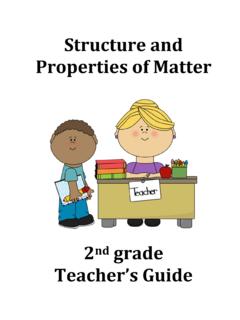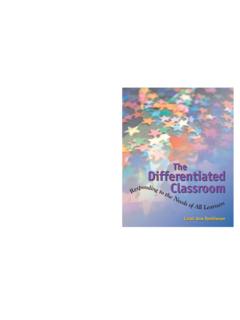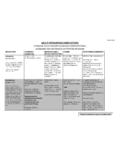Transcription of Pushes & Pulls - McCracken County Public Schools Home
1 Teacher s Guide Kindergarten Unit Forces and Interaction: Pushes & Pulls Physical Science: Forces and Interactions- Pushes and Pulls Teacher Background Information In helping students be successful in the performance expectations, activities are geared to build on the inherent knowledge and experience that five year olds have already acquired and use their knowledge in a wider range of tasks. Students are given the opportunity to examine, measure, reflect upon, describe, and discuss how Pushes and Pulls of various objects are used to produce and control motion. Students are asked to analyze what they have already observed, internalized, and made sense of through experience and observation.
2 Students begin to form a clear sense of what cause and effect is. Within the content of motion, students are also given the opportunity to begin to recognize and apply the nature of science. The unit gives students a series of experiences that challenge their thinking about motion. By exploring motion in a variety of settings, students are better able to think about their understanding so they can analyze and interpret observations and data, synthesize ideas, build new knowledge, and clarify their understanding. Retrieved from: Developed for the Introduction to the Next Generation Science Standards CREATE for STEM Institute, Michigan State University, May 28, 2013 Nancy Karre/BCAMSC and Paul Drummond/Wayne County Prior Knowledge Students entering kindergarten have considerable knowledge regarding motion of toys and how to apply a push or pull to get the toy moving.
3 Students have observed the motion of toy cars, balls, wagons, etc. They think of forces as active Pushes and Pulls that are needed to explain an object s motion. Students know that different strengths of Pushes on a toy car will give them different results. The prior experience of motion of toys serves as a background to investigate strengths of Pushes and Pulls on a variety of objects in terms of distance, speed, and direction. They can understand that when a ball has rolled out of sight, it still exists. Part Retrieved from: Developed for the Introduction to the Next Generation Science Standards CREATE for STEM Institute, Michigan State University, May 28, 2013 Nancy Karre/BCAMSC and Paul Drummond/Wayne County AND TCAPS Pushes and Pulls Kindergarten Science Unit Possible Student Misconceptions: - All things fall down, but heavy things fall faster.
4 (we are not assessing gravity, but could be a common misconception.) - The speed of an object is directly related to the force currently applied. - If an object is moving, there is a force acting on it in the direction of motion. - Constant motion requires a constant force. - Everyday experience suggests that objects set into motion eventually come to a stop when no obvious external force acts on them. At the end of the Unit, Kindergarteners will need to understand: - a push and/or a pull as a force that affects motion. - that an object moves in the direction of the push or pull .
5 - that Pushes and Pulls can speed up, slow down, or change the direction of an object. - that size, weight, and shape of an object affects its motion. And be able to: - describe motion in terms of objects around it - make observations of motion and generate questions about motion - plan and conduct simple investigations about motion - construct simple charts from motion data and observations - share ideas about motion and communicate findings orally and through drawings and writings - recognize patterns in the effect of Pushes and Pulls on objects - gather information from books and one another - demonstrate concepts of motion through illustrations and performances - analyze a design in terms of its ability to change direction or speed
6 Of a moving object Above Retrieved from: Developed for the Introduction to the Next Generation Science Standards CREATE for STEM Institute, Michigan State University, May 28, 2013 Nancy Karre/BCAMSC and Paul Drummond/Wayne County Helpful Next Generation Science Standard Materials on the Web: * Click Next Generation Science Standards tab on top * Appendices E, F, and G (on the left side of webpage) are extremely helpful - Appendix E: Disciplinary Core Idea Progressions - Appendix F: Science and Engineering Practices - Appendix G: Crosscutting Concepts See next page for Next Generation Science Standards Unit Plan Forces and Interactions Kindergarten Unit : push and pull Lesson Pacing/page # Materials Important Notes to Teachers Camera - need to be taking pictures throughout this unit (see Lesson 7) Book List push AND pull BOOKS: Motion, by Darlene R.
7 Stille How Things Move, by Don L. Curry Give it a push ! Give it a pull !, by Jennifer Boothroyd And Everyone Shouted, pull ! , by Claire Llewellyn push and pull , by Lola M. Schaefer push and pull , by Patricia Murphy push and pull , by Charlotte Guillain Move it!: Motion, Forces and You, by Adrienne Mason SCIENTIFIC METHOD BOOKS: Scientists Ask Questions, by Ginger Garrett Everyone is a scientist, by Lisa Trumbauer It s a Date, Let s Investigate!, by Kelly Doudna It s an Event When We Experiment, by Kelly Doudna I ll Use Information For My Explanation by Kelly Doudna Where is it?
8 Is it Moving? by Delta Education Lesson 1 Let s Get Movin , Movin 2 days Materials for charting Hokey Pokey Song Plain White Paper Pencils Motion, by Darlene R. Stille Lesson 2 Pushes and Pulls Treasure Hunt Possible 2 days Give it a push ! Give it a pull !, by Jennifer Boothroyd Lesson 3 Round and Round we go! Where we stop nobody knows? Introduce Investigations, Experiments, Data 2 days Masking tape Slide or merry-go-round Stopwatch Sticky notes Scientific Method sheet in (not in student journal) Chart (teacher created, sample found in lesson) Extra adults (optional) Scientists Ask Questions, by Ginger Garrett Lesson 4 Down the Ramp 3 days Rope (jump rope) Round objects (golf balls, ping pong balls, cotton balls, Styrofoam balls, marbles, wooden spheres)
9 Cylinder objects (wooden cylinders, toilet paper rolls, soup cans, water bottles, pop cans) Toy cars Ramps Objects to add weight String/Yarn Books or objects to use to change ramp Stopwatches Rulers Introduce I in Student Journals Scientific Method sheet in Student Journals Pencils Lesson 5 Changing direction, starting, stopping 2 days Kick balls/soccer balls A way to take pictures or video Lesson 6 Science Centers 2 days push and pull books (see book list)
10 Venn Diagram Worksheet push , pull , push and pull Sort Worksheet Sticky notes Magazines Objects to sort Pencils Computers Hula Hoops (or materials to make circles for big Venn Diagram) Cotton balls Masking tape Measuring tape Straws Exploration Materials from Lesson 4 Tempera-paint White paper Smock and drop cloth Pipettes Paper Scissors Dominos Lesson 7 Writing a book 2 days Digital Photos of class taken throughout the Unit Paper Pencils Vocabulary Cards Book references Book-binding tools Extra handouts and assessments Various handouts for homework, morning work.





![ADA Compliance Checklist Guidance [APS] (Accessible ...](/cache/preview/5/c/4/b/f/1/b/5/thumb-5c4bf1b5b7dbcfe1843c76286083789d.jpg)








